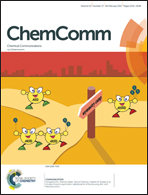Highly branched photomechanical crystals†
Abstract
When a suspension of the tert-butyl ester of 4-fluoroanthracene-9-carboxylic acid (4F9AC) was slowly hydrolyzed, highly branched photomechanical microcrystals of 4F9AC were grown. Exposure to UV light caused the branches to undergo a reversible sweeping motion that could be used to move and concentrate silica microspheres on a surface.



 Please wait while we load your content...
Please wait while we load your content...